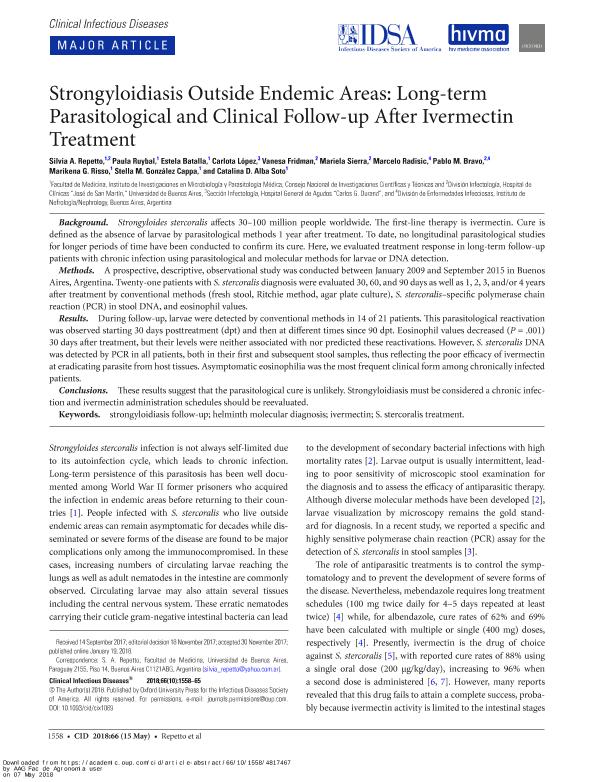Artículo
Strongyloidiasis Outside Endemic Areas: Long-term Parasitological and Clinical Follow-up after Ivermectin Treatment
Repetto, Silvia; Ruybal, Paula ; Batalla, Estela
; Batalla, Estela ; López, Carlota; Fridman, Vanesa; Sierra, Mariela; Radisic, Marcelo; Bravo, Pablo M.; Risso, Marikena Guadalupe
; López, Carlota; Fridman, Vanesa; Sierra, Mariela; Radisic, Marcelo; Bravo, Pablo M.; Risso, Marikena Guadalupe ; González, Stella Maris
; González, Stella Maris ; Alba Soto, Catalina Dirney
; Alba Soto, Catalina Dirney
 ; Batalla, Estela
; Batalla, Estela ; López, Carlota; Fridman, Vanesa; Sierra, Mariela; Radisic, Marcelo; Bravo, Pablo M.; Risso, Marikena Guadalupe
; López, Carlota; Fridman, Vanesa; Sierra, Mariela; Radisic, Marcelo; Bravo, Pablo M.; Risso, Marikena Guadalupe ; González, Stella Maris
; González, Stella Maris ; Alba Soto, Catalina Dirney
; Alba Soto, Catalina Dirney
Fecha de publicación:
05/2018
Editorial:
University of Chicago Press
Revista:
Clinical Infectious Diseases
ISSN:
1058-4838
e-ISSN:
1537-6591
Idioma:
Inglés
Tipo de recurso:
Artículo publicado
Clasificación temática:
Resumen
Background Strongyloides stercoralis affects 30-100 million people worldwide. The first-line therapy is ivermectin. Cure is defined as the absence of larvae by parasitological methods 1 year after treatment. To date, no longitudinal parasitological studies for longer periods of time have been conducted to confirm its cure. Here, we evaluated treatment response in long-term follow-up patients with chronic infection using parasitological and molecular methods for larvae or DNA detection. Methods A prospective, descriptive, observational study was conducted between January 2009 and September 2015 in Buenos Aires, Argentina. Twenty-one patients with S. stercoralis diagnosis were evaluated 30, 60, and 90 days as well as 1, 2, 3, and/or 4 years after treatment by conventional methods (fresh stool, Ritchie method, agar plate culture), S. stercoralis-specific polymerase chain reaction (PCR) in stool DNA, and eosinophil values. Results During follow-up, larvae were detected by conventional methods in 14 of 21 patients. This parasitological reactivation was observed starting 30 days posttreatment (dpt) and then at different times since 90 dpt. Eosinophil values decreased (P =.001) 30 days after treatment, but their levels were neither associated with nor predicted these reactivations. However, S. stercoralis DNA was detected by PCR in all patients, both in their first and subsequent stool samples, thus reflecting the poor efficacy of ivermectin at eradicating parasite from host tissues. Asymptomatic eosinophilia was the most frequent clinical form among chronically infected patients. Conclusions These results suggest that the parasitological cure is unlikely. Strongyloidiasis must be considered a chronic infection and ivermectin administration schedules should be reevaluated.
Archivos asociados
Licencia
Identificadores
Colecciones
Articulos(IMPAM)
Articulos de INSTITUTO DE INVESTIGACIONES EN MICROBIOLOGIA Y PARASITOLOGIA MEDICA
Articulos de INSTITUTO DE INVESTIGACIONES EN MICROBIOLOGIA Y PARASITOLOGIA MEDICA
Citación
Repetto, Silvia; Ruybal, Paula; Batalla, Estela; López, Carlota; Fridman, Vanesa; et al.; Strongyloidiasis Outside Endemic Areas: Long-term Parasitological and Clinical Follow-up after Ivermectin Treatment; University of Chicago Press; Clinical Infectious Diseases; 66; 10; 5-2018; 1558-1565
Compartir
Altmétricas



